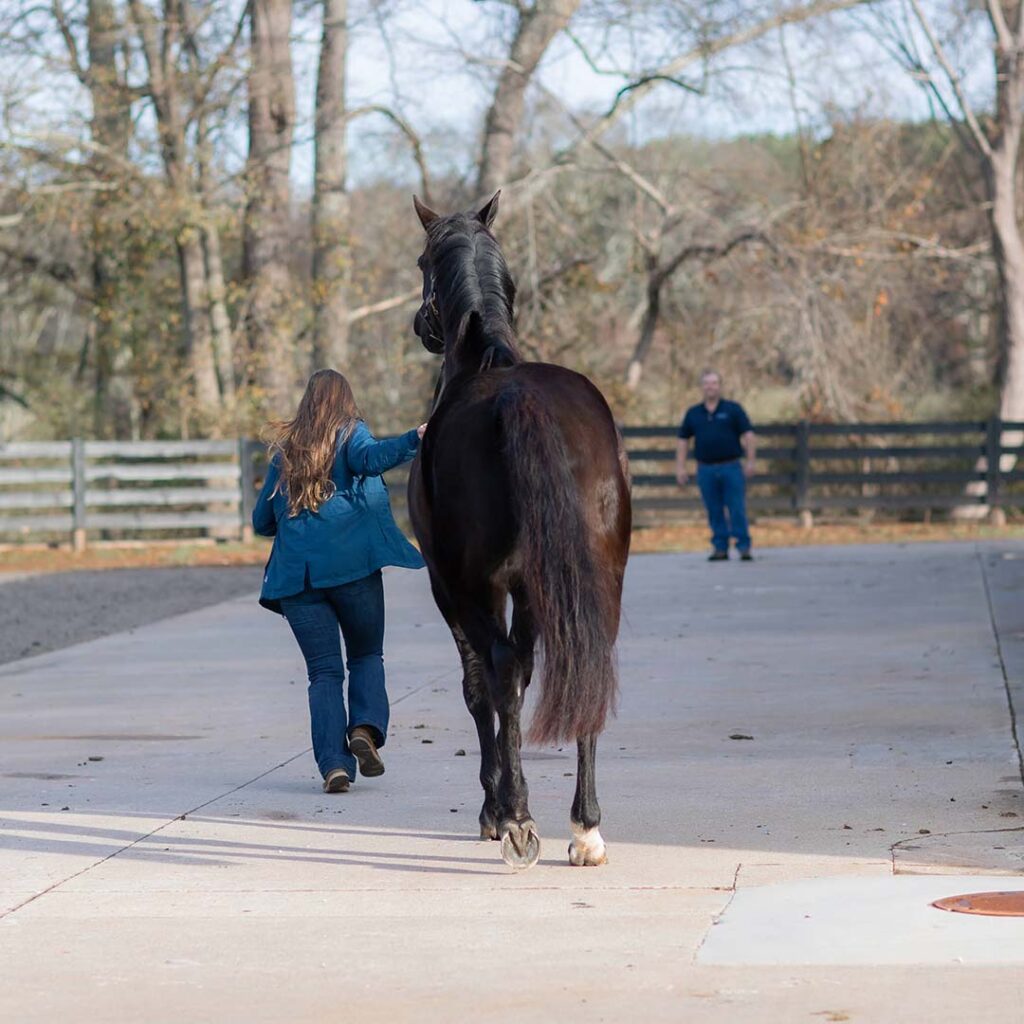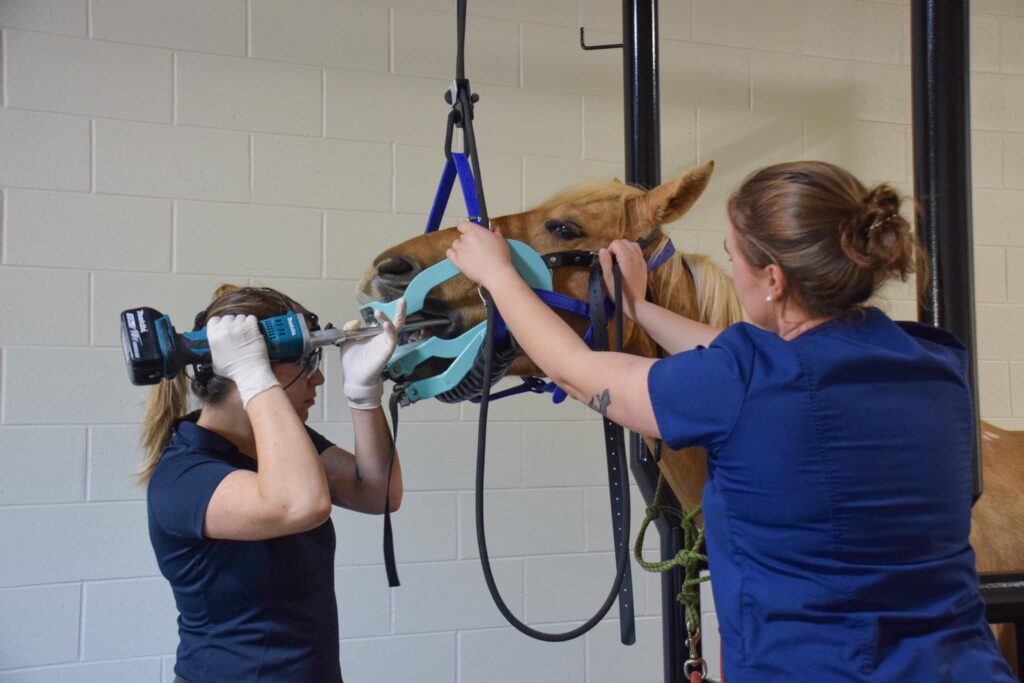The daily work of equine veterinary teams is filled with high physical demands. Horses are strong, heavy, and sometimes hard to handle, making the risk of injury ever-present. Practices can mitigate these risks by creating a culture that encourages and supports safety by teaching safe handling techniques, reducing patient stress, and developing effective protocols for each examination and procedure.
Beyond the horses and the risks associated with their handling, the daily tasks in an equine practice, such as lifting heavy objects and working long hours with poor body positioning, can cause injury. In this article, we introduce the importance of design considerations for employee safety and injury prevention in an equine hospital.
Lameness Work-Up
Lameness work-up spaces are important areas of focus, because both horses and employees are in motion.

- When designing a lameness work-up space, reduce traffic flow, noise, and distraction from arriving vehicles and horses and other hospital activities. On your hospital’s site, direct traffic flow to create the safest and quietest lameness work-up area possible.
- If the hospital is in a climate where freezing occurs, consider covering the lameness examination area to reduce the risk of slip injuries from working on icy pavement.
- If using concrete, be diligent with its finish texture. The best finish texture for concrete is a medium broom finish. Smooth concrete is far too slippery, and heavy textures reduce the surface area between the hoof and the pavement. Keep the concrete free from standing water.
- Asphalt may be used for work-up areas, but only if the surface is unsealed.
Treatment and Dental Spaces

A hospital should have a set of stocks not only for safe restraint of horses but also to help support safe and ergonomic working conditions. The doctor and team should be able to work without contorting their bodies. A tie bar on top of the stocks will help position a horse’s head during dental procedures as illustrated in the photo from Countryside Veterinary Services.
Exam and treatment spaces should be quiet, sound-insulated from other areas in the hospital, and large enough to move safely with a horse to avoid injury. These spaces often have rubber flooring to reduce the risk of slipping. Fortunately, rubber materials also help support human bodies and reduce strain from standing.
Positioning the Human Body Relative to the Horse
Chiropractic and acupuncture treatments require access to the top of a horse’s back. For these therapies, the doctor will need to stand on a stool. We recommend stools that comply with OSHA and
ANSI Standards. These will be rated as “heavy duty,” but they do not need to be heavy to lift. Aluminum is an excellent material for a step stool because it is both durable and lightweight. Industrial supply distributors such as Grainger and Uline can be good sources for workplace-safety-compliant step stools.
A pit can be useful for veterinarians performing standing surgical procedures involving the lower limbs. While these pits are not necessarily common in equine practices, if utilized they must be constructed to reduce, not increase, hazards by helping the doctor and team work on a lower limb at an ergonomic level. Pits are best combined with stocks to safely restrain the horse.
Surgical Procedures
Fully anesthetized procedures are risky for both the horse and the staff. We like to involve the surgeon and their team in decision-making to be sure the design is carefully considered, from induction to recovery. Some items we recommend include:
- Consider whether the horse or the table where the horse is lying moves. It is more ergonomic to move the horse from place to place using a hoist beam and trolley system than it is to move a horse on a table. Keep this in mind when laying out the hoist system.
- Position the bottom of the hoist beam at a minimum of 13’4” above the finished floor. This clearance prevents horses’ heads from dragging when they’re hoisted. Staff members should not use their body strength to move the horses’ bodies any more than necessary.
- Rubberized flooring is not needed in the surgery room because horses are fully anesthetized. Instead, provide anti-fatigue mats for the surgery team to stand on. Choose medical-quality mats that can be fully cleaned and disinfected.
- Lighting should be mounted overhead, where it can be positioned to avoid shadows and eye strain, while remaining out of the way of the hoist system.
Pharmacy and Laboratory

Seated work must be performed ergonomically, as sitting for long periods can cause injury. Fortunately, design solutions for these spaces are straightforward and inexpensive.
- Purchase adjustable height stools and chairs.
- Consider the microscope station specifically. It often works well to have the counter lower at this station so the stool or chair can be placed higher, to allow for looking through the eye pieces of the microscope comfortably. Alternatively, use a drafting height chair, as is illustrated in the photo above. Also note the stacking cabinet for laboratory equipment. This allows easy access to different machines without using much counter space.
- Provide a variety of counter heights for different tasks:
- Thirty inches for seated tasks.
- Thirty-six inches for standing tasks.
Barn Design
Design the medical barns to be safe and easy for your employees to work.
- Use retractable hose reels so staff members do not injure their shoulders from the daily task of dragging hoses.
- If using buckets, position spigots outside of stalls so they can be filled in place.
- Use rubber mats or rubber pavers in barn aisles for slip-free surfaces.
- Use wider aisles and stall doors in medical settings to allow horses to be assisted when they are down.
- Consider the unfortunate event of a deceased patient, and ensure they can be moved from the barn (or surgery area) without difficult maneuvering.
- Design barn bulk storage and feed areas to be easily accessible from the outside. Use wide doors to allow for vehicular access to prevent the need to lift or transport bulky materials.
Create a Culture of Safety
Per the US Bureau of Labor Statistics data from 2023, veterinarians have an injury rate four times that of the average worker. While a practice cannot control all factors, creating a culture that promotes and encourages safety in all forms, including those involved in daily tasks, will help employees avoid workplace injury, keep their bodies healthy over the course of their careers, and create a practice that supports the well-being of not only the patients but also the staff.
Related Reading
- Concepts in Cleanability for Equine Practices
- Update Your Equine Clinic to Reduce Medical Errors
- Design Considerations for Equine Veterinary Practices
Stay in the know! Sign up for EquiManagement’s FREE weekly newsletters to get the latest equine research, disease alerts, and vet practice updates delivered straight to your inbox.

![[Aggregator] Downloaded image for imported item #18711](https://s3.amazonaws.com/wp-s3-equimanagement.com/wp-content/uploads/2025/10/20105749/EDCC-Unbranded-14-scaled-1-768x512.jpeg)
![[Aggregator] Downloaded image for imported item #18782](https://s3.amazonaws.com/wp-s3-equimanagement.com/wp-content/uploads/2025/11/03125751/EDCC-Unbranded-13-scaled-1-768x512.jpeg)

